Finding the ideal settings is crucial in qualifying your separator to perform at optimal capacity and efficiency.
August 19, 2021
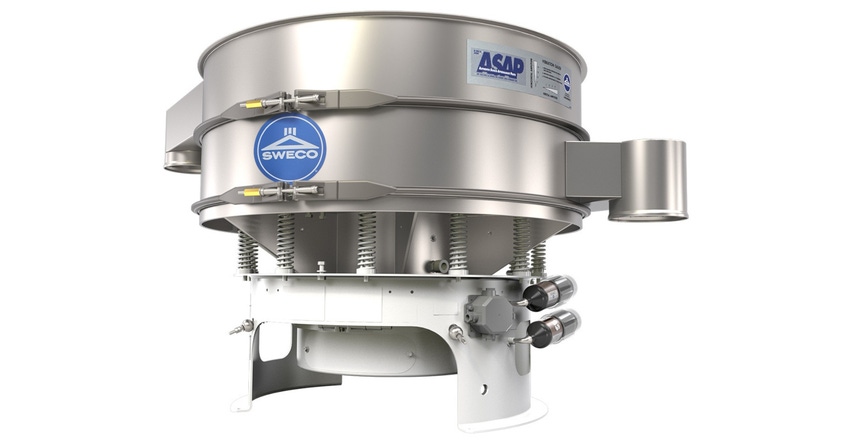
Jeff Dierig, global marketing manager, SWECO
A standard round vibratory separator uses a mounted vibrating screen cloth enclosed in frames as the medium on which the particle sizing or liquid/solid separation occurs. The separator vibration is attributed to a motion generator consisting of a double-end shaft motor with eccentric weights on the top and bottom of the vertically mounted motor. The motor rotates counterclockwise when viewed from the top. As the motor rotates, the weights generate a radial centrifugal force causing the spring mounted machine to vibrate.

Figure 1
The top weight has an adjustable force output and a fixed position on the motor shaft. The bottom weight also has an adjustable force output but includes a variable angular orientation in relation to the top weight.
There are three independent variables or adjustments to a vibratory separator: top force, bottom force, and lead angle. Adjusting these variables will change the horizontal amplitude, vertical amplitude, and phase angle respectively. The top and bottom weights slide away from and closer to the motor shaft to adjust the horizontal (top) and vertical (bottom) amplitudes (see Figure 2). The bottom weight set can be rotated around the motor shaft in relation to the static top weights to produce the lead angle. By changing these variables, a user can adjust the material pattern on the screen to optimize their process.

Figure 2
Adjusting Amplitudes
The top eccentric motor weights were designed to be at the separator’s center of gravity (CG). Force acting at CG will cause uniform planar motion in the mass. In this case, the top weight force spinning at CG will create a horizontal radial motion of the machine. Thus, the horizontal amplitude will change when the top weight settings are increased or decreased. Increasing the top weight setting will yield more horizontal amplitude while decreasing the weight setting will yield less horizontal amplitude.
The bottom eccentric motor weights are directly below the top weights and, thus, below the separator’s CG. The bottom weight will induce a torque about the CG creating vertical motion as the machine tilts from the vertical axis. As with the top weight settings, increasing the bottom weight setting yields more vertical amplitude and decreasing the weight setting will yield less.
Adjusting Lead Angle
In vibratory separators, lead angle is defined as the counterclockwise (CCW) angle between the top and bottom weight when viewed from above. When the weights are vertically aligned, there is a zero-degree lead angle. When the bottom weight is 120° CCW from the top weight, and the motor is spinning CCW, the bottom weight leads the top weight. This means the maximum vertical motion generated by the bottom weight will occur 120° of motor rotation before the maximum horizontal motion generated by the top weight.
While the top and bottom weights (horizontal and vertical amplitudes) can influence the material flow pattern on the screen, the lead angle is the control parameter which gives a round vibratory separator unparalleled functionality by controlling the material flow pattern in the separator.
Material Flow in Vibratory Separators
Now that we have a basic understanding of the machine’s input parameters--top weight, bottom weight, and lead angle--we can discuss how the differences in these parameters can affect the flow of the material in the separator.
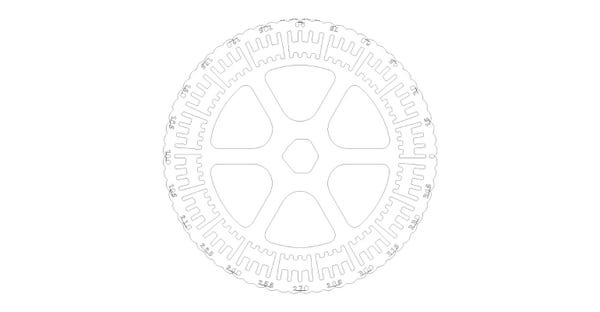
Figure 3
Most vibratory round separator weight systems have lead angles available in five-degree increments between 0-355° (see Figure 3). Even though there are instances where a higher lead angle would be appropriate, nearly all applications will fall within the 0 and 90° lead angle range. If we were to split that range into three subranges (low = 0-30°; mid = 30-60°; high = 60-90°), we could say that the majority of applications would fall in the mid-level range of 30-60°.
In a separator with a 0° lead angle, if fed in the middle of the screen, the material will move from the center radially across the screen to the frame. This setting on most applications will provide insufficient separation and the material will typically rope around the edge of the screen without completely discharging. There are applications where this type of setting would be appropriate, but they are few.
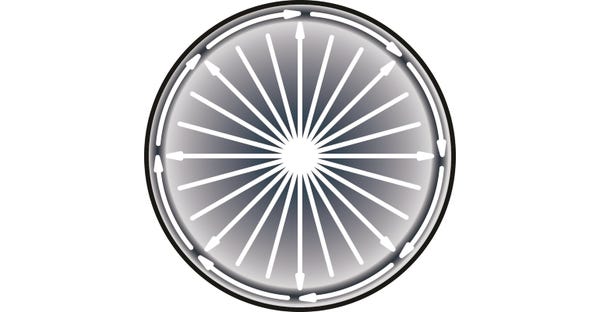
0° lead – material is thrown straight and gives insufficient separation
The lower lead angles will move the material from the center of the screen radially to the frame. As lead angles increase, the material begins to take on a spiral pattern on the screen, each 5° increment producing a more pronounced spiral affect. At a 15° lead angle, the material spiral pattern is prominent enough to become noticeable on the screen.
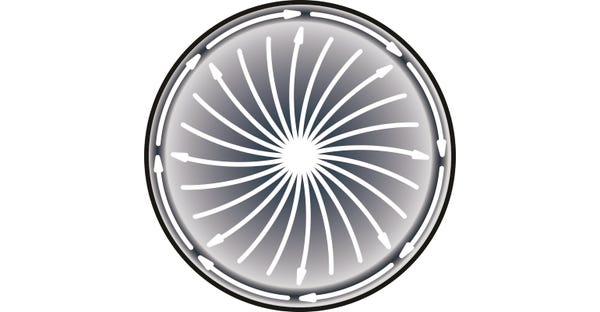
15° lead – material begins to spiral
While the lower lead angles move the material radially away from the center to the periphery of the screen, the mid-level lead angles move material from the center to the edge in a spiral pattern. This spiral pattern maximizes the amount of time that the material stays on the screen. In many applications, this is ideal since the longer the material stays on the screen mesh surface, the more chances that the smaller fraction makes its way through the screen. This can increase the efficiency of the process. A 30-35° lead angle delivers a motion that provides a maximum efficient screening pattern, maximizing the amount of time that the material stays on the screen.
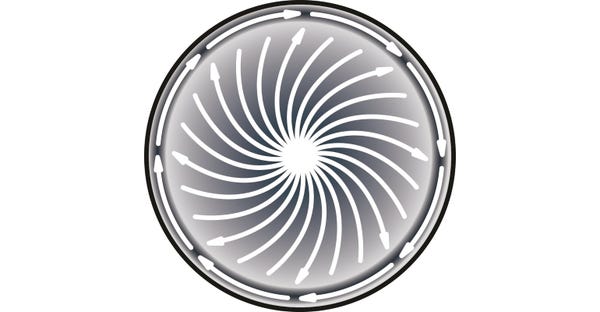
35° lead – gives material maximum efficient screening pattern
As the lead angle increases through the mid-level range, the spiraling of the material increases along with the speed of the material discharge. However, as the lead angles increase into the higher range, the material tends to turn in on itself, making its way back towards the center of the screen, creating difficulty for the oversize material to discharge. There are many applications that require a higher lead angle. Some scalping applications where the material needs to be held on the screen longer to ensure all the good material passes through and does not get discharged with the coarse material could use a lead angle in the 70-90° range.
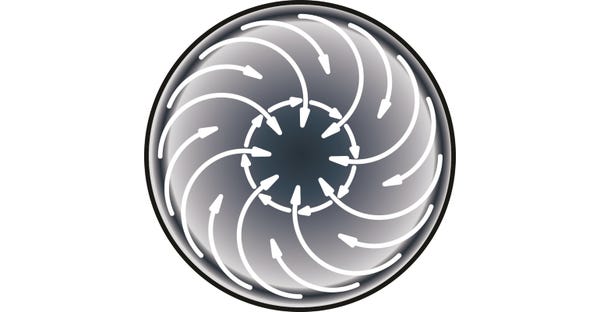
90° lead – keeps oversize material from being discharged and assists in receiving maximum throughput of minus material
Separation Processes
Different manufacturers may use different terminology when describing the processes of separation. But no matter what terms are used, most applications will fall under one of the four primary separation processes: Sizing, scalping, gravity filtering, and wastewater clean-up.
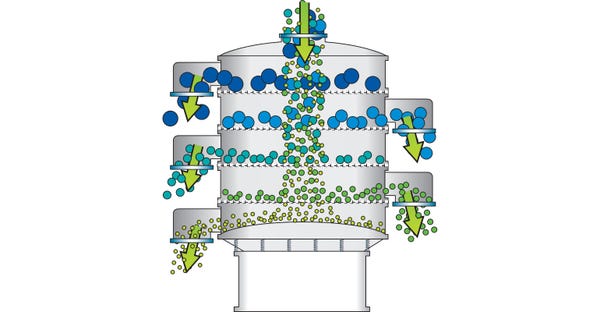
Sizing
Sizing is the segregation of a variety of solid particles into separate groups containing comparable sizes. Depending on the type and size of the machine, some separators can produce up to five fractions simultaneously.
Various food and chemical products are sized using vibratory round separators. Most sizing applications will be covered with lead angles from 30-60°. Typically, sizing requires that the material reside on the screen as much as possible. So, creating an efficient spiral and increasing the residence time will provide cleaner, efficient cuts and maximize throughput.
However, there are dedusting applications that a much lower lead angle (0-10°) would be required. A product like dog food has a low percentage of fines and a high volume of overs. The separator needs to remove the fines (dust) and move the good material (dog food) off the screen quickly to handle the higher feed volume. The lower lead angle is ideal for an application with these requirements.

Scalping
Scalping is the removal of a small quantity of undesirable oversize particles in a high-throughput process. Typically, the material needs to be held on the screen longer to ensure all the good material passes through and is not discharged with the coarse material. When the application has minimal oversize material, a higher lead angle (70-90°) can be used if the oversize doesn’t need to be discharged. But if the oversize material is significant, then the lead angle should be a little lower (40-60°) in order to allow the material to discharge.
With most scalping applications, to account for the high volume of fine material going through the screen and exiting the machine, the bottom frame is modified into what is termed a “scalping frame” which provides a steep-sloped discharge to facilitate the material exiting the separator. So, in addition to the higher lead angle, greater horizontal and vertical amplitudes are required due to the added weight of the scalping frame.
Many powdered food and drinks are typical scalping applications that will utilize a higher lead angle to hold the material on the screen longer than other processes.
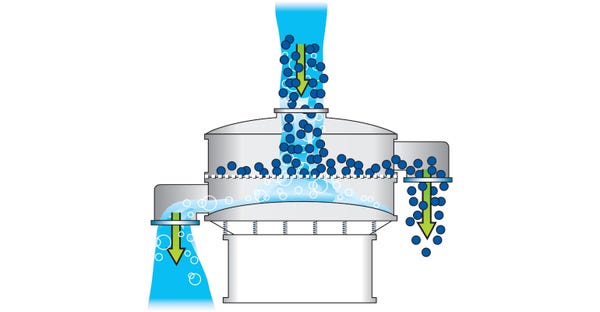
Gravity Filtering
Gravity filtering, or product recovery, is the separation of oversize solids from all types of slurries or dewatering solid/liquid mixtures. The objective is to separate the liquid from the solids to reclaim any usable solids or clarifying liquids, either of which having further economic value.
A typical application that may use gravity filtering would be fruit juices or other types of food products. Consider an orange juice processing facility. The process would require the removal of various solids (peels and pulp) from the end-product (juice) prior to the final stages of processing. Typical lead angles for such an application, as well as most wet applications, would be between 40-60°.
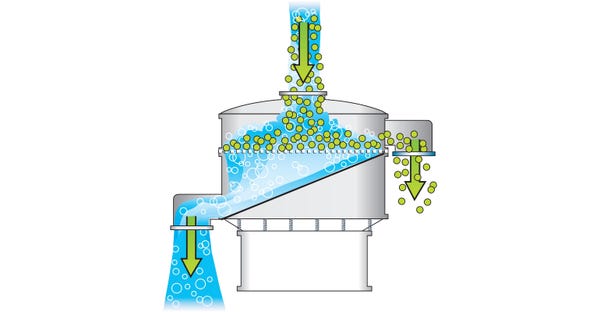
Wastewater Clean-Up
Wastewater clean-up, or water pollution control, is the efficient recovery of usable solids from a waste stream or the cleaning of a water stream for the purpose of re-use.
Most if not all food processing plants will have a waste stream of some sort that needs cleaning. Canneries, for example, will need to clean the fruits and vegetables before final processing. This wash water, which would typically have large percentage of solids in it, will either be discarded or reused. If the intent is to dispose of the water, the water cannot simply be sent to the sewers. There would be environmental concerns and government consequences. The solids that are in the water will need to be removed prior to being discarded. Similarly, if the water is to be reused, it must first be cleaned. That is why most food processors utilize vibratory separators to clean their waste streams. And as with most wet applications, a typical lead angle for wastewater clean-up applications will fall between 40-60°.
Even if two materials are similar in nature, it does not mean the exact parameter settings on the separator will be used for both materials. Take sugar and salt for example. Both can be processed in granulated form and have similar attributes, but that doesn’t mean that their separator settings will be identical. Even the same material from different processors could potentially use different settings because characteristics of the materials could be slightly different which could make the material react differently on the screen. Each application will have its own optimal settings.
Because the same or similar products can still be so different, before purchasing any vibratory separation equipment, the best practice is to have the manufacturer perform testing on your material to make certain the separation equipment is feasible as well as to determine the optimal settings on the separator. This will assure you that you’re choosing the correct equipment and present you the settings that will deliver the maximum efficiency and throughput for the material.
All the lead angle references mentioned in this article were assuming the use of a standard round separator running at 1,200 RPM without any add-on features. If the separator were to add a self-cleaning kit, ball-tray assembly, ultrasonic technology, or any other feature, this could alter the material pattern on the screen, thus requiring a settings adjustment to correct for the add-on. Similarly, if the separator were a high-speed unit running at 1,800 RPM, this could dramatically alter the pattern. It could require a lead angle change from 30° to as high as 90° due to the added speed.
There are many factors that can provoke adjustments to the settings on a separator. But finding the ideal settings is crucial in qualifying your separator to perform at optimal flow capacity and efficiency levels of any process.
Jeff Dierig is global marketing manager, SWECO (Florence, KY). For more information, call 859-727-5116 or visit www.sweco.com.
You May Also Like


